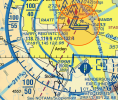FPK1
Line Up and Wait
Just curious, when there is a TCAS-RA incident, are the pilots required to report it to the FAA or someone?
Well, you inform ATC (which is the FAA) ASAP, so there’s that.Just curious, when there is a TCAS-RA incident, are the pilots required to report it to the FAA or someone?
 www.adsbexchange.com
www.adsbexchange.com
And @Kritchlow , what about company? Are you supposed to notify them also? Like ‘log’ it or something?1. We are required to comply with an RA, even if it conflicts with ATC instructions.
2. We are required to report the RA to ATC then report when we are clear on conflict. ATC will not give us control instructions while the RA is active.
3. We are required to file a written report after having an RA.
Flight: "[Callsign], TCAS RA"
ATC: "[Callsign], Roger"
Flight: "[Callsign], Clear of conflict"
The report we have to file is to the company. They handle any required reports to the regulators.And @Kritchlow , what about company? Are you supposed to notify them also? Like ‘log’ it or something?
Whom ever assigned the initial FL200, it’ll be on their tapes. In an RA all she has to do is monitor your progress and issue traffic / safety alerts. On the controller’s end it’s a non event because their separation standards go out the window until approved separation is reestablished.Only time I experienced an RA was when I was right seat in a Citation heading south to Naples, Florida. We were level at FL 210 when a departure out of Fort Myers was cleared to FL 200. That set off the TCAS and my pilot climbed immediately. He reported the RA to ATC and the controller asked, "What was your last assigned altitude? " Then she asked the other aircraft the same question. I pointed out to the pilot that she wanted that on the tape.
Thanks, seems like the controller in the above video put two planes too close together and I wondered if he would ever hear about it for training purposes...1. We are required to comply with an RA, even if it conflicts with ATC instructions.
2. We are required to report the RA to ATC then report when we are clear on conflict. ATC will not give us control instructions while the RA is active.
3. We are required to file a written report after having an RA.
Flight: "[Callsign], TCAS RA"
ATC: "[Callsign], Roger"
Flight: "[Callsign], Clear of conflict"
Depends, with these vids a lot of times they leave critical information out of the recording. In this case, while it sounds like the controller is using visual separation, I never heard him say such. All you hear is that both aircraft have each other in sight. If indeed he had visual sep, an RA doesn’t mean anything on the controller side.Thanks, seems like the controller in the above video put two planes too close together and I wondered if he would ever hear about it for training purposes...
Probably not.Thanks, seems like the controller in the above video put two planes too close together and I wondered if he would ever hear about it for training purposes...
We file a report with company. God only knows where it goes from there.And @Kritchlow , what about company? Are you supposed to notify them also? Like ‘log’ it or something?
Yeah. The recording doesn't even start until after SKY5592 had probably been told to maintain visual separation.Depends, with these vids a lot of times they leave critical information out of the recording. In this case, while it sounds like the controller is using visual separation, I never heard him say such. All you hear is that both aircraft have each other in sight. If indeed he had visual sep, an RA doesn’t mean anything on the controller side.
I can hear/see nothing that puts the two planes TOO close together. The Controller was following all the rules. Yeah, they get close, but the scenario you see happens hundreds, probably thousands of times a day and night at airports with parallel runways. I went back and added 'and night.' Visual separation can get a little sketchy at night sometimes. Especially when the visibility is very good and you can see a sea of lights very far away. As I was watching this I was thinking about the, was it Lufthansa, incident at LAX a while back. Some airlines do not allow their pilots to accept Visual Separation at night.Thanks, seems like the controller in the above video put two planes too close together and I wondered if he would ever hear about it for training purposes...
The PC12 lined up on the wrong runway. That being said, they had 500ft separation at all times it seems, so no loss of separation.Like this situation. While the pilots of AAL had a problem with how close the PC12 was, technically the controller has approved sep (500 ft vert) for this condition. That’s why he’s so nonchalant in his instruction to the PC12 to box him out again.
Yeah and if the controller had cleared the PC12 that would have been bad. But with no approach clearance and I’d be willing to bet GDP was assigned at or above 2,500, there’s no threat of him descending. The system worked.The PC12 lined up on the wrong runway. That being said, they had 500ft separation at all times it seems, so no loss of separation.

